 Originally published November 6, 1998, in Comics Buyer’s Guide #1303
Originally published November 6, 1998, in Comics Buyer’s Guide #1303
No one can argue the absolute necessity of trying to get new fans, new readers on board. To present stories and concepts that will ideally stir the interests of those who are not currently reading comics and bring them into the hobby.
The last time that comics had massive or rapid expansion, it was driven by the collector mentality. The characters and stories were of no interest; rather, comics were being bought and sold purely as commodities. Purchasers had as much emotional attachment to the characters as stockbrokers have to AT&T stock. It’s just business, with no personal investment or interest. Unfortunately, if one is at all interested in the long-term health of the industry, then ways have to be found to stoke the fire of that interest once more. There are far too many things vying for the attention of potential young readers these days, and comic characters are a very small voice in a very loud wind.
So, companies continue to make efforts to bring in new readers, any way they can.
I have two recent examples of such, both available for under three dollars, and both aimed at substantially different audiences. One is quite charming, and the other is kind of… meh.
First up is Spider-Man: Chapter One.
Marvel Comics is apparently attempting to recapture its title as the House of Ideas. It doesn’t seem to matter that the ideas might be DC’s (having John Byrne reboot a flagship character) or just old (a recycling of a story first published more than three decades ago).
There’s our hero, posed much as he was on the cover of Amazing Fantasy #15. Unfortunately, as opposed to the original cover where the buildings were nicely in line with each other (as one would expect from a Kirby cover), the new version has the backgrounds somewhat out of whack, with apparently all the skyscrapers on the right hand side of the street positioned at about an 80 degree angle relative to the ones across the way, giving the impression that they’re about to topple over. Then again, considering the recent building collapses in Times Square, perhaps this is simply sardonic commentary on Manhattan’s crumbling structures.
Of course, that doesn’t explain Spidey’s webline, which is somewhat flaccid rather than properly taut as in the original. It also appears to be anchored to Spider-Man’s word balloon rather than a building. On the other hand, since the buildings are already in an apparent state of disintegration, that might be a wise move on the webslinger’s part. Spider-Man’s rather arch dialogue from the original (“Though the world may mock Peter Parker, the timid teenager, it will soon marvel at the awesome might of Spider-Man!”) has been replaced by the more colloquial, easier to read “Everybody laughs at the loser, Peter ParkerTM but no one’ll be laughing at the Amazing Spider-Man.” Of course, that still leaves us with the unidentified guy Spidey’s shlepping, who I always envisioned saying, “Ah hah! So you’re Peter Parker, huh!” to which Spidey could reply, like the Maxx, “Ðámņ! I was speaking out loud instead of thinking again!”
The story then proceeds in flashback form, presumably so we can get Spidey upfront faster. Fair enough. The captions are somewhat overwrought and frontloaded with adjectives (“The last soft breezes of dying summer have been swept away on the keening edge of a gathering storm. The wind is cold this autumn night, but the tears that soak this black and scarlet mask are scalding hot, heated by the fires blazing in the soul of a young man who has just seen his world come to an end.”) but at least the buildings are in line with each other, so we shouldn’t be too upset.
Spidey flashes back throughout his life. Here Byrne endeavors to update our hero, with Aunt May and Uncle Ben presenting him with a computer as a kid rather than a microscope. Indeed, one of the purposes of the reboot is to do away with all those nasty topical references which date the original. But old, jarring references (Spidey referring to himself as being “more unpopular than Kruschev”) have been replaced by new jarring references. (Teenagers of recent vintage—they have to be recent if young Peter is getting a PC for his birthday—debating over tickets to a Rolling Stones concert? The Stones? If the sequence is set about five years ago, then a Nirvana concert, maybe. Or perhaps They Might Be Giants. But the Stones, during their Steel Wheelchair Concert? I dunno about that.)
Byrne consolidates the origins of both Spidey and Doc Ock into one nuclear accident, which is probably a smart move. At least, I certainly thought it was smart when Stan Lee first did it in his aborted movie treatment for the Spider-Man film, which was adapted into short story form for the collection, Ultimate Spider-Man. Likewise Byrne’s more educated handling of proper precautions used for a demonstration for radioactivity, while robbing the original of much of its naive charm, at least makes it more believable to a more knowledgeable audience.
While Peter convalesces in a hospital, Uncle Ben purchases yet another PC (my God, these people were more loaded than the computers) and is assisted to his car by a guy who looks sort of like an evil Alfred E. Neuman. This fellow will turn out to be the burglar who winds up robbing the Parker’s home—the burglar who, while casing the house, spots Spider-Man emerging from the upper floor window and jumps to the conclusion that Spidey is a second-story man as well.
It’s all part of Byrne’s take on the assorted coincidences that plague Spidey’s origin. (“I addressed a couple of points that had never quite been made to work as well as they might,” Byrne explains in an essay. “Why did that burglar travel all the way from midtown Manhattan to that house in Queens, of all the houses in Queens?”)
Unfortunately, in endeavoring to explain those coincidences, Byrne piles one confusion upon another. How did the burglar know where Uncle Ben lived? He could have checked the phone book, I suppose, but “Parker” is a common name (Queens information lists over a hundred “Parker”s) and why assume that Ben lived in Queens to begin with just because he bought a computer there? The burglar is next seen in Manhattan, being chased by a uniform police captain—from the Forest Hills precinct. What the hëll is the cop—who looks to be about sixty—doing wandering that far afield from his normal precinct? What’d he do, tail the burglar all the way from Queens, while in uniform?
C’mon. If the Manhattan-to-Queens jump was that bothersome to Byrne, why not just set the big wrestling confrontation at Nassau Coliseum, which is a stone’s throw from Queens? Or even just make up an exhibition hall in Forest Hills. Anything’s better than this tortured rationale.
Why would the burglar, upon seeing Spider-Man emerge from the house, assume that Spidey was likewise a crook? What would be the sense in Spidey “casing” the place, as the burglar suggests, if Spidey’s already inside? Spidey clearly isn’t carrying any loot; costume’s too tight, no place to put it. Much more logical would be for him to assume (correctly) that Spidey lives there. For that matter, why did the burglar wait so long to attempt the robbery? If he’s after the computer, better to hit the house fast. Get the thing while it’s still in the box. Easier to carry, easier to resell if it’s brand new.
That aspect of the Spider-Man origin which Byrne considered so unacceptable—the apparently random coincidence—was in fact one of the strongest aspects of the origin.
It was that awful randomness, the incredible unpredictability, that underscored the terrible lesson that Spider-Man learned. Thirty years ago, the robber appeared out of nowhere, disappeared back into nowhere, only to show up from nowhere again. His facelessness made him all the more frightening and disturbing. It accented the capriciousness of fate, and brought into strong relief the eternal vigilance that would be Spider-Man’s price for the powers he had acquired.
The new version suffers from TMI—Too Much Information. Rather than fate pointing its fickle finger and smushing Uncle Ben, Ben instead becomes a piece in a Byzantine game of being endlessly “cased” by a burglar who alternates between being excessively canny and cautious sometimes, and other times possessing the IQ of an egg salad sandwich. I mean, here’s a guy who’s just been positively ID’d by a police captain (outside his precinct, but never mind that) while attempting a robbery backstage at the wrestling arena.
This would be a good time for the thief to get the hëll out of town. If he needs quick cash, he can try lifting a few wallets before bolting to Penn Station, Grand Central or Port Authority. Instead he heads back to his normal stomping ground, where an APB has no doubt already been put out for him by the cop who spotted him (because he knows him, remember, as opposed to his originally being a fleeting and unidentified figure) so he can try to burglarize the house and pop Uncle Ben. It’s too involved and rather annoying.
Instead of being a random and frightening act of violence, Ben’s fate is sealed the moment he steps out of the computer store. The burglar was more effective when he seemed almost a force of nature, a faceless incarnation of street violence and misused responsibility. By making him too much of a character, a once-elegantly simple morality tale has become needlessly involved and convoluted, basically because Byrne overthought it.
If I were interested in trying to stir up interest in a young fan, I would be more inclined to hand him a copy of I Hate Superman than Spider-Man: Chapter One.
What’s that, you say? Well, I Hate Superman is an oversized book for kids, published by Little, Brown about two years ago at the unfortunately prohibitive price of $13.95. However, I picked it up just recently at the far more appropriate remainder price of $2.99.
No kiddified Superman tale is this. Written by none other than long-time Superman scribe Louise Simonson, and illustrated by Kevin Altieri (director of Batman: The Animated Series) and painted by wife Kathy Altieri (currently attached to DreamWorks SKG, with animation credits including The Lion King), I Hate Superman tells the story of two brothers in the nastier section of town. While young James hero-worships the Man of Steel, his other idol is older brother Mike, who sticks up for his cape-wearing kid brother when other kids tease him.
As the story unfolds, James spots a robbery at a local shop and summons the passing Superman. To James’ horror, however, he discovers that one of the robbers is none other than big brother Mike, running with a bad crowd. What transpires next is—particularly considering the target audience—almost heartbreaking.
“His heart sank. ‘You can’t take him, Superman!’ James cried, running toward them. ‘It’s a mistake. That’s my brother!’
“‘I’m sorry,’ Superman said softly. ‘But I have to turn them all over to the police. Your brother wasn’t the one with the gun, but he was breaking the law.'”
Off goes Mike to jail (juvenile hall, presumably) and James’ adoration for Superman turns to blind fury. He blames Superman for carting away his brother, and even worse, he blames himself for alerting Superman to the situation in the first place. Consequently he starts vandalizing the neighborhood, spray painting “I Hate Superman” all over the place. Naturally Superman can’t help but notice the rather harsh criticism, and confronts the hurting lad:
“James plowed into Superman, pounding him as hard as he could with both fists. ‘I don’t want to be like you anymore!’ (James said). Superman let James hit him until the boy was just too tired to move. Then Superman gathered him into his arms and held him until James’s sobs quieted.
“I didn’t arrest your brother because you betrayed him. I arrested him because what he was doing was wrong. There was a gun. People could have been seriously hurt,’ Superman said. ‘It’s good to love your brother, but you don’t have to act like him. Or me,’ Superman added.”
Pretty heartfelt and deep for what is ostensibly a kids’ book. There are one or two minor quibbles: The first sentence of the book, for instance, is “Our apartment is sweltering…!” Not exactly a common word used by small kids, or any kids.
And the charmingly cartoony artwork features an assortment of nice bits, ranging from a pair of spindly cats who show upon practically every page, to the name “Walter” (as in Louise’s husband, Walter) etched in graffiti, to the revelation that James and Mike live on the corner of 35th Street and North Yancy. If you’re someone who’s got a mad on for a superhero, where else but Yancy Street would you reside?
The series of books also boasts Batman: The Joker’s Apprentice, written by Chuck Dixon and illustrated by John Calmette. I didn’t spot that one, but if it’s anything approaching the quality of this one, it’s a shame that the series apparently ended with these two installments. This is precisely the sort of project we need in order to get more readers.
And now if you’ll excuse me, it’s time for me to sit down with Ariel and watch The Superfriends on the Cartoon Network. Can’t start ’em too young, you know.
(Peter David, writer of stuff, can be written to at Second Age, Inc., PO Box 239, Bayport, NY 11705.)
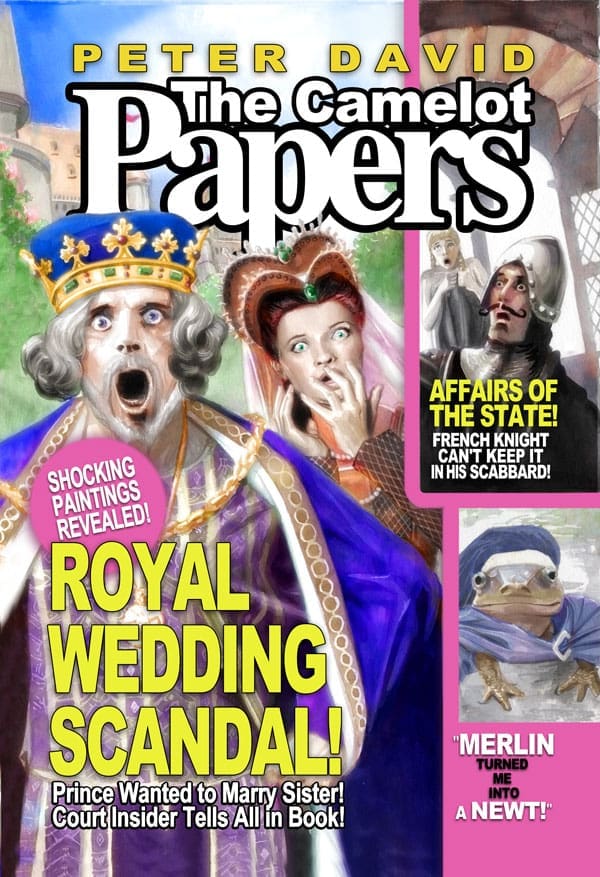
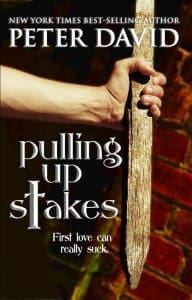
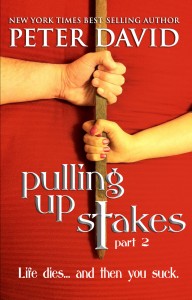
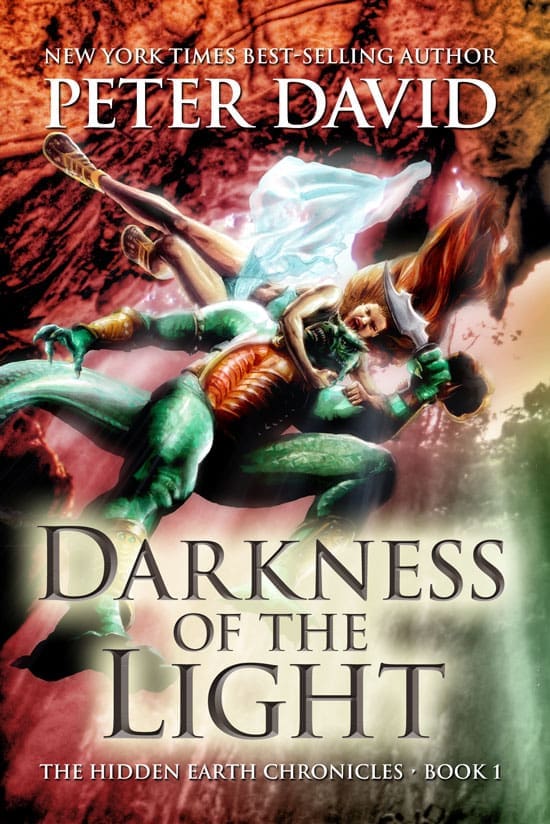
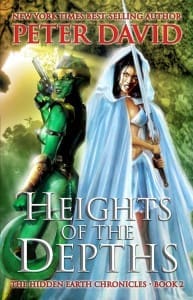
Not sure if it suffered from TMI or TCBH.
Lots of books, both originals and reboots,as well as films based on the various comic book properties started suffering from Too Clever By Half when it came to origins. It’s one thing to insist on tying up most of the loose ends by the end of a story, but it seemed like there was a good few years where everyone wanted to tie everything together in chapter one. Heroes and villains had to be connected in the origin story, later major plot points were retconned into origin stories, early stories or major parts of the hero’s life and everyone seemed to be in a competition to make their twist on the new version more clever or more insanely complex than then last.
I kind of like life having a lot of random elements. That’s the way it really is and I’ve always found fiction that leans towards that VS working too hard to be too clever by half more enjoyable.
If there was one consistent thing that I thought deserving a good noogie with comic book film producers since the early ’90’s it was that the Hero and the Villain became such at largely the same time. Raimi’s Spider-Man? Parker gets bitten, Oswald goes green. Same Spidey time, same Spidey channel. The FF? Not only did the Four get their cosmic bath at the same time as Doom, HE WAS ON THE SHIP. Don’t recall that from the books. A sense of time passage will let the Hero grow into the powers, and the identity. Ditto with the villain. Real life often isn’t that neat and tidy, the two freelance jobs I got right after I got my pro camera notwithstanding.
Whatever happened to Louise Simonson, anyway? I miss her work.
Louise Simonson
http://en.wikipedia.org/wiki/Louise_Simonson
I’ve always had an interest in history, particularly American history. And, if there’s one thing I’ve learned, coincidence plays a much greater role in the world than some people would have us believe.
For example, I just finished listening to the unabridged audiobook of “My Thoughts Be Bloody” by Nora Titone. I originally thought it would be the story of the Lincoln assassination from the point of John Wilkes Booth. Instead, it was a history of the Booth family, beginning with Junius Brutus Booth, the patriarch. And one thing I learned was that Edwin Booth, John Wilkes’ brother and, by all accounts, the most accomplished actor of the family, began an affair with an older actress, with whom he traveled to Australia, where their relationship ended due to Booth’s alcoholism. The actress was Laura Keene, the woman whose company produced the play “Our American Cousin” (which Keene starred in), which Lincoln was attending when John Wilkes shot him.
Not enough? How about Sacagawea traveling with Lewis and Clark and the Corps of Discovery? The first of her tribe that they encountered was led by her brother, Chief Cameahwait. That might not sound such a coincidence — until you consider this meeting took place before the Corps reached the Rocky Mountains, which was far before they would reach Sacagawea’s homeland.
Then, there’s the deaths of John Adams and Thomas Jefferson. As many people know, Adams and Jefferson died on the same day. That’s not quite as remarkable as it might seem. Both men were elderly, even moreso for their time. Adams was 90, Jefferson was 83.
But then, you discover that the day they died was July 4th. Both men had a great deal to do with the Declaration of Independence. Jefferson wrote it, Adams pushed for its passage. It was, of course, signed on July 4, 1776.
What really would strain the credibility of any author, however, were this fiction is that the day both men died was July 4, 1826 — the 50th anniversary of the Declaration’s signing, and the day we now recognize as Independence Day!
Some people can (and I’m sure, will) put forth arguments over why these events aren’t really straining the laws of coincidence that much. But I’d say they make the events of Spider-Man’s origin a little less incredible.
Kim Metzger: If you want a good book about the point of views of Booth, Gauiteau and Mxyzptlk’s cousin (who killed McKinley) I’d suggest Assassination Vacation by Sarah Vowell.
Got it on CD, have listened to it at least three times. Oh, and McKinley’s assassin was Leon Czolgosz.
I’ve also seen the musical “Assassins” once.